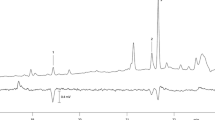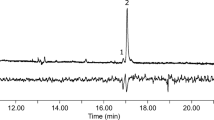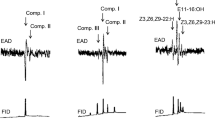Abstract
(Z)-11-Tetradecen-1-yl acetate, (E)-11-tetradecen-1-yl acetate, and (Z)-11-tetradecen-1-ol were previously reported as the sex pheromone in New York strains of the oblique-banded leafroller,Choristoneura rosaceana (Harris), and (E)-11-tetradecen-1-ol was tentatively identified in female tip extracts. For Okanagan Valley strains ofC. rosaceana, an additional component, (Z)-11-tetradecenal, was identified from female tip extracts by split-less capillary gas-liquid chromatography and mass spectroscopy and was strongly stimulatory in electroantennogram studies. In field tests, 3 mg of 96.5∶2∶1.5 (Z)-11-tetradecen-1-yl acetate, (E)-11-tetradecen-1-yl acetate, and (Z)-11-tetradecen-1-ol (containing approx. 1%E isomer) was not as attractive as female-baited traps, and significant numbers of European leafrollerArchips rosanus L. were attracted. The above blend with 1% (Z)-11-tetradecenal added was significantly more attractive than traps baited with femaleC. rosaceana, butA. rosanus males were still attracted. Increased percentages of (Z)-11-tetradecenal up to 4% caused increased catches ofC. rosaceana and decreased catches ofA. rosanus. Low amounts of (E)-11-tetradecen-1-ol and (E)-11-tetradecenal male also contribute to increased specificity of the synthetic pheromone blend toC. rosaceana.
Similar content being viewed by others
References
AliNiazee, M.T. 1976. Field studies on sex pheromone trapping of the filbert leafroller,Archips rosanus in Oregon.Ann. Entomol. Soc. Am. 69:820–824.
Arn, H., Battensweiler, W., Bues, R., Buser, H.R., Esbjerg, P., Guerin, P., Mani, E., Rauscher, S., Szocs, G., andToth, M. 1982. Refining lepidopteran sex attractants. Les médiateurs chimiques agissant sur le comportement des insects.INRA Coll. 7:261–265.
Arn, H., Stadler, E., andRauscher, S. 1975. The electroantennographic detector—A selective and sensitive tool in the gas chromatographic analysis of insect pheromones.Z. Naturforsch. 30:722–725.
Bierl-Leonhardt, B.A., DeVilbiss, E.D., andPlimmer, J.R. 1980. Location of double-bond position in long-chain aldehydes and acetates by mass spectral analysis of epoxide derivatives.J. Chromatogr. Sci. 18:364–367.
Buckell, E.R. 1937. Seasonal reports. Annual Report, Dominion Entomology Laboratory, Vernon, British Columbia, Canada.
Duncan, D.B. 1951. A significance test for differences between ranked treatments in an analysis of variance.Va. J. Sci. 2:171–189.
Hill, A.S., andRoelofs, W.L. 1979. Sex pheromone components of the oblique-banded leafroller,Choristoneura rosaceana.J. Chem. Ecol. 5:3–11.
Klun, J.A., Chapman, D.L., Mattes, K.C., Wojtkowski, P.J., Beroza, M., andSonnet, P.E. 1973. Insect sex pheromones: Minor amount of opposite geometrical isomer critical to attraction.Science 181:661–663.
Klun, J.A., Plimmer, J.R., Bierl-Leonhardt, B.A., Sparks, A.N., andChapman, O.L. 1979. Trace chemicals: The essence of sexual communication systems inHeliothis species.Science 204:1328–1330.
Klun, J.A., Plimmer, J.R., Bierl-Leonhardt, B.A., Sparks, A.N. Primiani, M., Chapman, O.L., Lee, G.H., andLepone, G. 1980. Sex pheromone chemistry of female corn earworm moth,Heliothis zea.J. Chem. Ecol. 6:165–175.
Madsen, H.F., andMadsen, B J. 1980. Response of four leafroller species (Lepidoptera: Tortricidae) to sex attractants in British Columbia orchards.Can. Entomol. 112:427–430.
Madsen, H.F., andProcter, P.J. 1982. Insects and mites of tree fruits in British Columbia. British Columbia Miscellaneous Publication, British Columbia Ministry of Agriculture and Food, Bulletin 82-6.
Madsen, H.F., andVakenti, J.M. 1973. The influence of trap design on the response of codling moth (Lepidoptera: Olethreutidae) and fruittree leafroller (Lepidoptera: Tortricidae) to synthetic sex attractants.J. Entomol Soc. B.C. 70:5–8.
Madsen, H.F., Vakenti, J.M., andGaunce, A.P. 1984. Distribution and flight activity of oblique-banded and three-lined leafrollers (Lepidoptera: Tortricidae) in the Okanagan and Similkameen Valleys of British Columbia.Can. Entomol. 116:1659–1664.
Mayer, D.F., andBeirne, B.P. 1974. Aspects of the ecology of apple leafrollers (Lepidoptera: Tortricidae) in the Okanagan Valley, B.C.Can. Entomol. 106:349–352.
Nesbitt, B.F., Beevor, P.S., Hall, D.R., Lester, R., Sternlicht, N., andGoldenberg, S. 1977. Identification and synthesis of the female sex pheromone of the citrus flower moth,Prays citri.Insect Biochem. 7:355–360.
Proverbs, M.D., Newton, J.R., andLogan, D.M. 1966. Orchard assessment of the sterile male technique for control of the codling moth,Carpocapsa pomonella (L.) (Lepidoptera: Olethreutoidae).Can. Entomol. 98:90–95.
Riedl, H., andCroft, B.A. 1974. A study of pheromone trap catches in relation to codling moth damage.Can. Entomol. 106:525–537.
Roelofs, W.L. 1976. The scope and limitations of the electroantennogram technique in identifying pheromone components, pp. 147–164,in N.R. McFarlane (ed.). Crop Protection Agents. Academic Press, New York.
Roelofs, W.L., andNovak, M.A. 1981. Small-plot disorientation tests for screening potential mating disruptants, pp. 229–242,in E.R. Mitchell (ed.). Management of Insect Pests with Semiochemicals. Plenum Press, New York.
Roelofs, W.L., Hill, A., Cardé, R., Tette, J., Madsen, H., andVakenti, J. 1974. Sex pheromones of the fruittree leafroller moth,Archips argyrospilus.Environ. Entomol. 3:747–751.
Roelofs, W.L., Hill, A., Cardé, R., Cardé, A., Madsen, H., andVakenti, J. 1976. Sex pheromone of the European leafroller,Archips rosanus.Environ. Entomol. 5:362–364.
Shepherd, R.F. 1979. Comparison of the daily cycle of adult behavior of five forest lepidoptera from western Canada, and their response to pheromone traps.Bull. Soc. Entomol.Suisse 52:157–168.
Spain, J.D. 1982. Basic microcomputer models in biology. Addison-Wesley Publ. Co., Reading, Massachusetts.
Vakenti, J.M., andPeters, F.E. 1981. Final report on establishment of a pest management service in southern districts of the Okanagan Valley of B.C. COPI Project OSZ78-00231. Agriculture Canada.
Venables, E.P. 1924. Leafrollers attacking orchard trees in the Okanagan Valley.Proc. Entomol. Soc. B.C. 21:22–26.
Venables, E.P., andGillespie, D.G. 1926. Seasonal reports. Annual Report Dominion Entomology Laboratory, Vernon, British Columbia, Canada.
Weatherston, J., Percy, J.E., andMcDonald, L.M. 1976. Field testing ofcis-11-tetradecenal as attractant or Synergist in Tortricinae.Experientia 32:178–179.
Westigard, P.H., andGraves, K.L. 1976. Evaluation of pheromone-baited traps in a pest management program on pears for codling moth control.Can. Entomol. 108:379–382.
Author information
Authors and Affiliations
Additional information
Lepidoptera: Tortricidae.
Contribution No. 638, Agriculture Canada, Research Station, Summerland, British Columbia, Canada.
Rights and permissions
About this article
Cite this article
Vakenti, J.M., Gaunce, A.P., Slessor, K.N. et al. Sex pheromone components of the oblique-banded leafroller,Choristoneura rosaceana in the Okanagan Valley of British Columbia. J Chem Ecol 14, 605–621 (1988). https://doi.org/10.1007/BF01013910
Received:
Accepted:
Issue Date:
DOI: https://doi.org/10.1007/BF01013910




